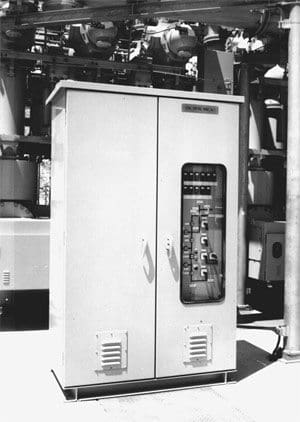
For ease of operation and convenience in wiring the GIS back to the substation control room, a local control cabinet (LCC) is provided for each circuit breaker position (Figure 1). The control and power wires for all the operating mechanisms, auxiliary switches, alarms, heaters, CTs, and VTs are brought from the GIS equipment modules to the LCC using shielded multiconductor control cables.
In addition to providing terminals for all the GIS wiring, the LCC has a mimic diagram of the part of the GIS being controlled. Associated with the mimic diagram are control switches and position indicators for the circuit breaker and switches. Annunciation of alarms is also usually provided in the LCC. Electrical interlocking and some other control functions can be conveniently implemented in the LCC.
Although the LCC is an extra expense, with no equivalent in the typical AIS, it is so well established and popular that attempts to eliminate it to reduce cost have not succeeded. The LCC does have the advantage of providing a very clear division of responsibility between the GIS manufacturer and user in terms of scope of equipment supply.
Switching and circuit breaker operation in a GIS produces internal surge voltages with a very fast rise time on the order of nanoseconds and a peak voltage level of about 2 per unit. These “very fast transient overvoltages” are not a problem inside the GIS because the duration of this type of surge voltage is very short — much shorter than the lightning impulse voltage.
However, a portion of the VFTO will emerge from the inside of the GIS at any place where there is a discontinuity of the metal enclosure – for example, at insulating enclosure joints for external CTs or at the SF6-to-air bushings.
The resulting “transient ground rise voltage” on the outside of the enclosure may cause some small sparks across the insulating enclosure joint or to adjacent grounded parts.
These may alarm nearby personnel but are not harmful to a person because the energy content is very low. However, if these VFT voltages enter the control wires, they could cause faulty operation of control devices. Solid-state controls can be particularly affected. The solution is thorough shielding and grounding of the control wires.
For this reason, in a GIS, the control cable shield should be grounded at both the equipment and the LCC ends using either coaxial ground bushings or short connections to the cabinet walls at the location where the control cable first enters the cabinet.











Dear Mr.Edvard Csanyi,
I want to do research a PhD student on reducing cabling between EHV/HV GIS & LCC by using I/O digital or analogue modules with control cable or FO cables media.
I need your kind support and advise on this.
Thanking you in advance.
I have question regarding LCC panel testing..
Can LCC panels be tested using PLC? How?
this website is a boon to the electrical engineers…………………
Thanks Ananth! Glad you find it usefull.